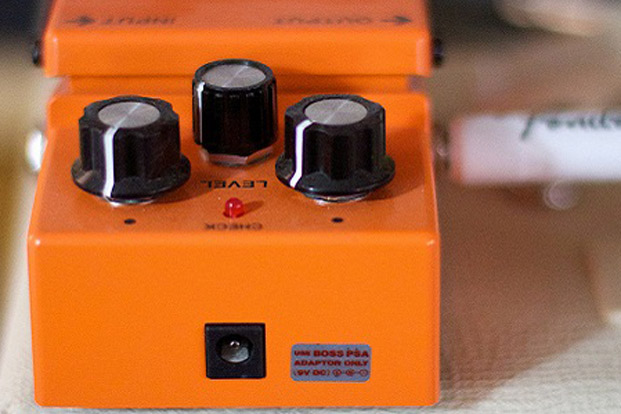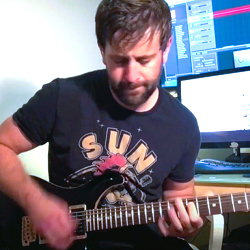Using Distortion with an Acoustic Guitar: Best Practices

This is an abridged version of the Overdrive Pedal for Acoustic Guitar Guide article, published at Guitar Chalk.
There's a lot of uncertainty about using acoustic guitar distortion.
Does it actually work?
Will it cause too much feedback?
What pickup or pedal should I use? Should I use an amp or go straight through a PA system?
The topic is ambiguous, at best.
But, I can tell you for certain, overdrive and your acoustic guitar can play nice. Moreover, I can give you conventional wisdom and the best practices that will allow you to do the following:
Get The Pick Newsletter
All the latest guitar news, interviews, lessons, reviews, deals and more, direct to your inbox!
- 1. Add a slight boost to your acoustic signal
- 2. Use a moderate amount of distortion
- 3. Move back and forth between a clean and "dirty" sound
- 4. Avoid feedback.
Before we look at pedals, let’s try and answer some of the above questions.
Amp or PA system?
In my experience, and in most cases I've heard of, it's better to run a distorted acoustic guitar through an amplifier, as opposed to going straight into a PA system.
This is because feedback typically stems from a PA system’s monitor facing an acoustic guitar, which sends sound waves from the source (the guitar) back into that same source, thus creating feedback.
Because of this, you'll have better luck getting your signal into an amplifier, distorting it via a pedal and then sending it to a PA system by micing your amp. This also will reduce the need for your guitar’s signal to be in the monitors (you’ll hear it directly from your amp).
However, experiences will certainly vary, thus exceptions to the rules are not uncommon.
Is an acoustic amp necessary?
You don't need a specialized acoustic amp to play a distorted acoustic guitar.
In fact, I've noted that regular electric guitar amplifiers, particularly warm-sounding tube amps, tend to work better for distorted acoustics than their acoustic counterparts.
Just be sure to use a clean and balanced EQ on your amp as a base, and get your distortion from a pedal, instead of the amp itself.
More on the pedals later.
What kind of acoustic pickup should I use?
A soundhole pickup is usually the most effective way to amplify your acoustic guitar and add distortion.
To improve your odds of staying feedback-free, use a pickup that covers the entire soundhole, like the Fishman Neo-Buster.
Here are a few additional noise-cancelling options:
• Seymour Duncan "Woody" Hum-Cancelling Pickup
• Fishman Neo Passive Magnetic Soundhole Pickup
• LR Baggs Active Magnetic Acoustic Soundhole Pickup (highly feedback resistant).
How important is a soundhole cover?
While you can get them in the form of a pickup, soundhole covers are more commonly produced as standalone feedback reducers that work in conjunction with a pickup already installed inside the body of your acoustic.
They're a good thing to try first (if you already have the pickup inside your guitar) because they're really cheap.
Planet Waves makes a soft rubber version that’s moldable and fits most acoustic guitars.
Which overdrive pedal for acoustic guitar works best?
Overdrive for acoustic guitars shouldn’t be overly heavy. If the signal is too intense, you'll have feedback problems regardless of the pickup arrangement you've put together. Instead of heavy distortion and high gain, go for a simple, smooth overdrive sound.
For example, the Boss BD-2 Blues Driver produces this kind of distorted tone exactly. It’s anything but aggressive.
Using what I’ll call an “acoustic-friendly” distortion source improves the odds that feedback problems will be avoided.
Let's roll through a couple pedal recommendations (other than the Blues Driver) that fit the bill.
1. Voodoo Lab Sparkle Drive Mod
The Voodoo Lab Sparkle Drive MOD is identical to the original Sparkle Drive, yet with a few additional settings that allow you to choose different distortion modes based on your stylistic leaning.
Most are on the smoother side of the spectrum. For example, you can use the MOD knob for a bluesy midrange grind or a more bass-heavy thickened tone.
It's nice to have this variety since most of the MOD settings are subtle enough to work with your acoustic guitar’s signal, provided you’re reasonable about the gain level.
The "CLEAN" knob
While I appreciate the versatility I get from the MOD options, the single most helpful feature for acoustic players is the CLEAN knob.
This is a fantastic tool for acoustic rigs, since it allows you to dial in a blend between your original clean signal (with a slight boost) and the distorted signal, thus maintaining the natural resonance coming from the body of your acoustic guitar.
The benefit is two-fold:
1. You can replenish the natural tone of the acoustic's clean response that might otherwise be “covered” in a distorted signal
2. Feedback reduction becomes incredibly easy by simply changing the clean/distortion mix.
Check the following demo video around 45 seconds in.
He bumps the CLEAN knob up to half way, bringing his guitar's clean signal back into the mix and reducing the volume of the distorted signal.
The Sparkle Drive is one of the few distortion pedals I’ve seen that has this feature.
While distortion pedals without the blend control can still work with acoustic guitars, it's hard to recommend them above the Sparkle Drive Mod since it has the tonal smoothness and versatility we're looking for, in addition to the signal blending feature.
2. BBE Acoustimax Sonic Maximizer
If you'd prefer a pedal specifically designed for acoustic guitars, the BBE Acoustimax is a great option, both for distortion and in-depth acoustic equalization.
Your distortion comes from the GAIN knob that sits on the left side of the pedal.
A few additional acoustic-friendly features include:
• Line level out
• Pre/Post (switchable) DI output
• Ground lift.
These features give you more options in terms of output, as they allow you to easily run your signal to either an amplifier or a PA system (via the DI output), a convenience that often benefits acoustic players in a performance environment.
The ground lift and notch filter will also reduce feedback and help to quell excess noise from the distortion.
A power adapter is included at no extra charge.
Better than the Sparkle Drive?
While probably the best standalone pedal for acoustic distortion, the Sparkle Drive does distortion and nothing else. You might want acoustic distortion and additional EQ controls for your rig. If so, the Acoustimax is a more comprehensive option that will give you both features in one stompbox.
However, either pedal can be an ideal fit in the proper context.
As far as overdrive for acoustic guitar is concerned, I can recommend them both without hesitation.
What You Should Avoid
If you don’t go with either of the two pedals I’ve recommended:
I would advise you avoid any kind of distortion with "metal" or "heavy" in the title, opting instead for lighter distortions and overdrives.
As mentioned previously, extremely high-gain or saturating distortions will dull your acoustic guitar's natural tone and almost certainly make feedback an unfixable problem.
Keep this in the back of your mind when you pick out an acoustic guitar distortion pedal. Aim to strike a balance between adding a little extra gain that enhances your sound, or drowning out your acoustic guitar entirely behind a wall of noise and feedback.
If you have questions about the distortion and acoustic guitar setup, drop them in the comments below and I’ll do my best to assist.
Good luck out there.
Resources Used in this Post and Further Reading
Overdriving Acoustic Guitars Gibson Article: Some basic tips and best practices for using distortion with an acoustic guitar.
Monte Montgomery's Gear Page: Montgomery has long been known for using a distorted acoustic guitar, thus his gear page is a useful tool.
Monte Montgomery Guitar World Interview: Once again, an in-depth look at Montgomery's rig gives some good insight on distorting an acoustic guitar.
Nirvana playing "Man Who Sold the World" Live in New York: Kurt Cobain uses distortion on an acoustic guitar, which is a great example of the tone done right.
Bobby Kittleberger is the founder and editor of Guitar Chalk, a GuitarWorld.com contributor and author of the Music Theory for Guitar Players in Plain English. You can get in touch with him here or via Twitter.
Bobby is the founder of Guitar Chalk, and responsible for developing most of its content. He has worked with leading guitar industry companies including Sweetwater, Ultimate Guitar, Seymour Duncan, PRS, and many others.
“While the odd corner has clearly been cut, these are true Gibsons with all the individuality that this brand exhibits”: Gibson J-45 Special and Hummingbird Special review
“Fender has stripped back the price – but has it gone too far paring back the sounds, too?” Fender Standard Acoustasonic Telecaster review










